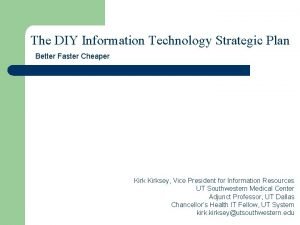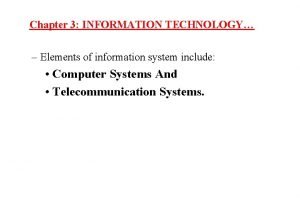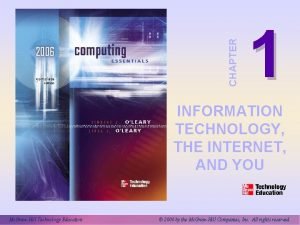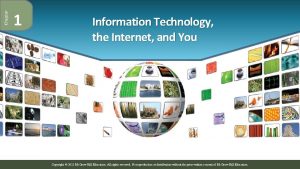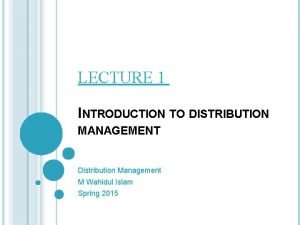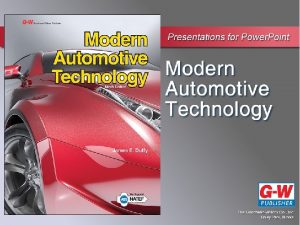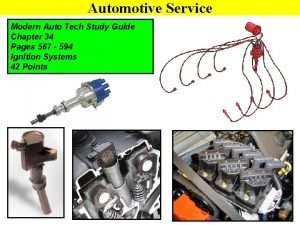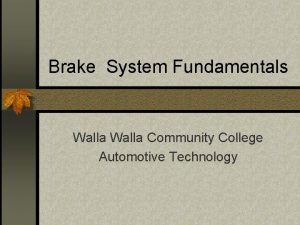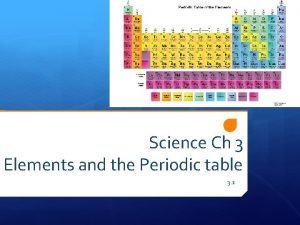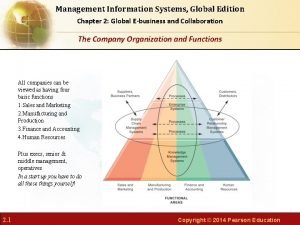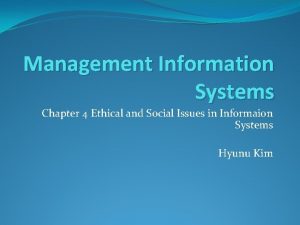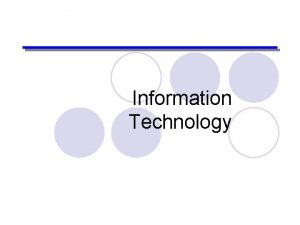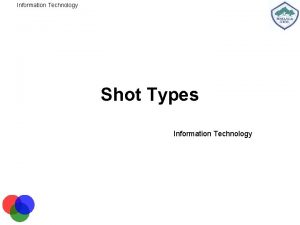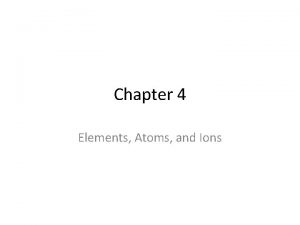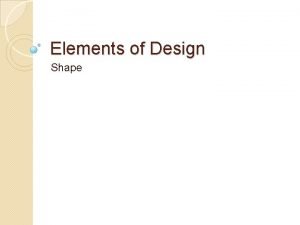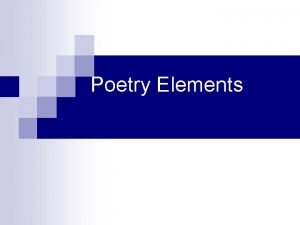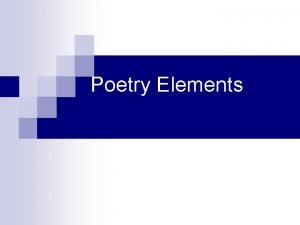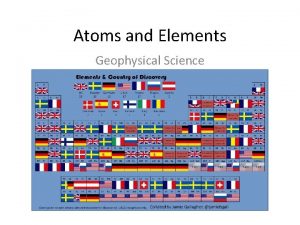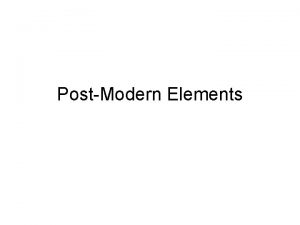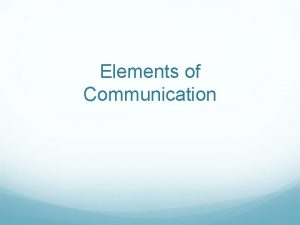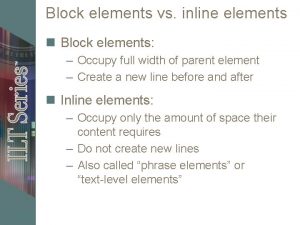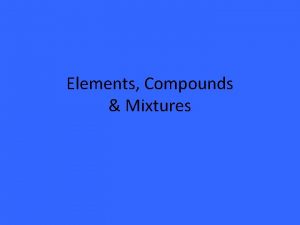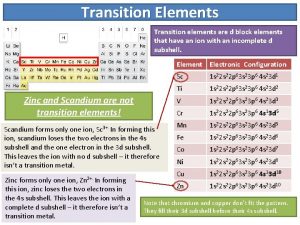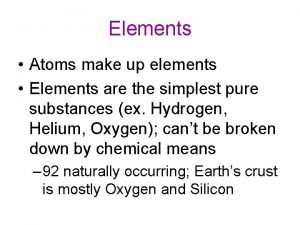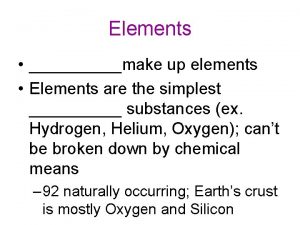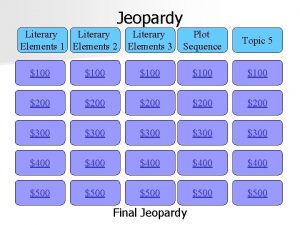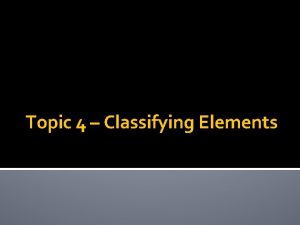Chapter 3 INFORMATION TECHNOLOGY Elements of information system




















- Slides: 20

Chapter 3: INFORMATION TECHNOLOGY… – Elements of information system include: • Computer Systems And • Telecommunication Systems.

INFORMATION TECHNOLOGY… • Computer systems are made up of five components: – hardware, – software, – information (database), – people, and – procedures.

INFORMATION TECHNOLOGY… 1. Hardware – – Input devices, Processors, Output devices, Secondary Storage devices

INFORMATION TECHNOLOGY… • Input devices – Functions – Some examples • • • Keyboards Point-of-Sale terminals mouse Image Scanners Bar code scanners Microphones

INFORMATION TECHNOLOGY… • The processor – Function • Components – the control unit and – the arithmetic/logic unit • Memory – Function – Types • RAM • ROM

INFORMATION TECHNOLOGY… • Output Devices – Function – Some examples • monitors, • printers, • plotters

INFORMATION TECHNOLOGY… • Secondary Storage Devices – Characteristics – Examples • • Diskettes Hard disks Optical disks Magnetic tape

INFORMATION TECHNOLOGY… 2. Software – Systems Software – Application Development Software

INFORMATION TECHNOLOGY… • Systems Software – Operating Systems • Supervisory – Resident – Transient • Job management program • I/O management program – Communications Software – Utilities

INFORMATION TECHNOLOGY… • Application Software – – – – – Word Processing Software File Management Software Database Management Software Project Management Software Accounting Software Photocomposition and Desktop Publishing Statistical Software Training and Tutorial Software Thought Processing Software Industry Specific Software

INFORMATION TECHNOLOGY… • Application Development Software – Machine Languages – Assembly Languages – Higher level Languages

INFORMATION TECHNOLOGY… 3. People – Users – Information Technology Professionals

INFORMATION TECHNOLOGY… • Users – Hands-on users – Indirect end users – User managers – Senior managers

INFORMATION TECHNOLOGY… Information Technology Professionals • • • Programmers Systems Analysts Project managers Network specialists Trainers Computer operators

INFORMATION TECHNOLOGY… 4. Procedures – – Operating Procedures Backup and Recovery Procedures Security Procedures Development Procedures

INFORMATION TECHNOLOGY… • Operating Procedures – Are concerned with the execution of an application. – Typically, operations procedures include: • How a system or application is used. • Who is authorized to use the system and what each individual is authorized to do. • How often certain applications are to be used. • Where results of processing should go.

INFORMATION TECHNOLOGY… • Backup and Recovery Procedures – describe when and how to make extra copies (called backup copies) of • data, • information, or • software to protect yourself against losses. – Should any of these be lost or accidentally changed, the backup copy can be used to restore the original version so that a minimum amount of work is lost. – Recovery procedures describe the actions to be taken when data and information or software must be recovered.

INFORMATION TECHNOLOGY… • Security Procedures – Security procedures are designed to safeguard data centers, communications networks, computers, and other IT components from accidental intrusion or intentional damage. – Backup copies protect against loss; security procedures prevent actions that could lead to that loss. – Common security procedures entail • limiting individual access to certain databases and • creating secret passwords that users must input into the computer to perform certain functions.

INFORMATION TECHNOLOGY… • Development Procedures – These explain how IT professionals should • describe user needs and • develop applications to meet those needs. – They may also prescribe • when and • how software should be acquired and put into use.

INFORMATION TECHNOLOGY… 5. Information/Data – – Text Sound Images Other type of Data
 Information technology system
Information technology system Information technology chapter 3
Information technology chapter 3 Information technology the internet and you
Information technology the internet and you Chapter 1 information technology the internet and you
Chapter 1 information technology the internet and you Elements of accounting information system
Elements of accounting information system Introduction of distribution management
Introduction of distribution management Chapter 81 brake system technology answers key
Chapter 81 brake system technology answers key Chapter 80 brake system technology ase answers
Chapter 80 brake system technology ase answers Suspension system
Suspension system Chapter 34 ignition system technology
Chapter 34 ignition system technology Chapter 80 brake system technology
Chapter 80 brake system technology Elements of drama in literature
Elements of drama in literature Overhead allocation
Overhead allocation Molecular element
Molecular element Http //elements.wlonk.com/elements table.htm
Http //elements.wlonk.com/elements table.htm Setting in a folktale
Setting in a folktale Features of a folktale
Features of a folktale Management information system chapter 2
Management information system chapter 2 Mis chapter 3
Mis chapter 3 Management information system chapter 4
Management information system chapter 4 Management information system chapter 1
Management information system chapter 1
